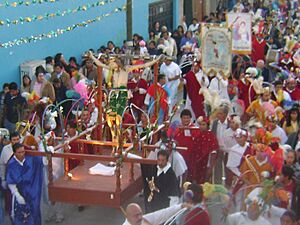Lord of the Chapel facts for kids
The Lord of the Chapel is a special statue of Jesus on the cross. In Spanish, it's called Señor de la Capilla, and in the Otomi language, it's known as Zidada Nikjä. This important statue is found in the Saint James Apostle parish in Santiago Tequixquiac, Mexico. Many people believe this statue helped protect them from sickness and diseases. It became the patron saint of Santiago Tequixquiac and is one of the most famous statues in Mexico State.
Artists likely created the statue around 1570 at the Actopan ex-monastery. It was made using different materials like sticks, agave fiber, and plaster. The artist who made it is not known. The statue comes from the time when Spain ruled Mexico.
The Statue's Story

During the time of Spanish rule, many statues of Jesus on the cross were made. These statues were often carved from a light material called cane paste. This was a special tradition of the native people in New Spain (which is now Mexico). It allowed them to create religious statues that were not too heavy.
Similar statues were found in other churches in the region. For example, there was the Lord of the Wonders in El Arenal, and the Lord of Tlapala in Visitación. There was also the Lord of the Sacromonte in Amecameca and the Lord of Chalma in Chalma. The Lord of the Chapel statue was first kept in a small church in Apaxco. Later, it was moved to the town of Tequixquiac, where it remains today.
What the Statue Looks Like
The statue of Jesus is about 1.73 meters (or about 5 feet 8 inches) tall. It was made in the early 1600s. The cross that the statue is on is made of walnut wood. It also has small, decorative pieces of ivory. These ivory pieces are called tablets and were brought all the way from the Philippines.
See also
 In Spanish: Señor de la Capilla para niños
In Spanish: Señor de la Capilla para niños


